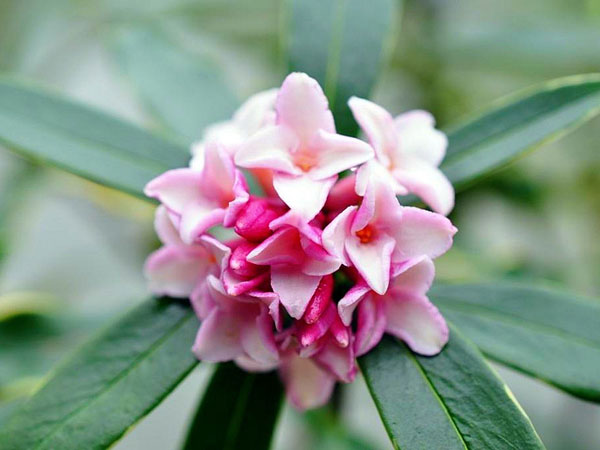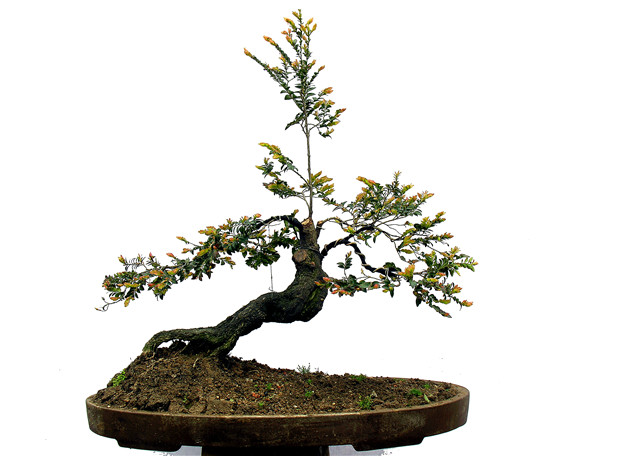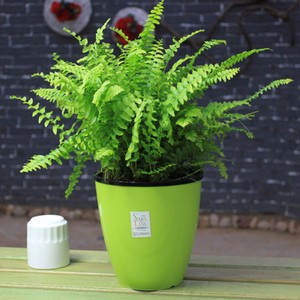The culture method of Daphne odorifera
Daphne also known as: sleeping incense, Penglai purple, amorous tree, dew nail, white Ruixiang, Qianlixiang, Ruilan, snow skin, cotton skin. Originally produced in Huiyuan Rock, Wuyishan City, Fujian Province, it has been cultivated for more than 100 years. Mainly distributed in the inner mountains of Wuyi Mountain (Yanshan). Since the 1980s, Wuyishan City has been cultivated in a certain area. Some domestic scientific research and teaching units have been introduced. Evergreen shrubs, ca. 2 m tall. Branches slender, smooth and glabrous. Leaves alternate; elliptic-oblong, 5-8 cm long and 1.5-2 cm wide, entire, apex obtuse or mucronate, base subcuneate, dark green above, light green below, all smooth and glabrous. Flowers fragrant, white or reddish, ca. 1.2 cm, capitate, arising from branches; bracts 6-10, lanceolate; calyx tube outside pilose, 4-lobed, ca. 8 mm; Corolla; stamens 8; pistil 1, ovary smooth. The fruit is pulpy, spherical and red. The florescence is from March to May. Next, the editor of the net will introduce Ruixiang flowers.

The culture method of Daphne odorifera
Cultivation method of potted Daphne odorifera: soil
Potted Phnom Penh Daphne, pot soil should be fertile and loose, rich in humus with acid rotten leaf soil, mixed with appropriate amount of river sand and mature cake fertilizer.
Cultivation method of potted Daphne odorifera: watering
Phnom Penh Ruixiang root is fleshy, usually maintenance and management should pay special attention to control watering, such as too much watering, basin soil is too wet for a long time, easy to cause rotten roots. After the rain, the stagnant water in the basin must be poured out in time.
Cultivation method of potted Daphne odorifera: sunshine:
Although Phnom Penh Daphne likes semi-shade, it should be placed in a sunny environment in winter and spring. During the growth period, such as sufficient light and appropriate fertilizer effect, it can make Ye Dai, flowers and flowers strong. It should be placed in a well-ventilated shady place in summer, and water should be sprayed to cool down when it is hot.
Culture method of potted Daphne odorata: temperature:
After Frosts Descent, Phnom Penh Daphne moved into the sunny part of the room, the room temperature was kept at about 5 ℃, and the watering was controlled; the water content of the basin soil was controlled at about 45% before it could survive the winter.
Matters needing attention in the Culture of potted Daphne odora
Potted Daphne should keep the potted soil semi-dry and semi-wet and apply fertilizer once in spring and autumn. In spring, the mixed liquid fertilizer of 30% rotten bean cake and chicken manure is used in the sprouting stage, and the fertilizer concentration is light in late September in autumn. The time for fertilization should be on a sunny day, preferably before 10:00 in the morning. Spray water on the leaves after 5 p. M. on the day of fertilization. Water can not use newly released tap water, it is better to be exposed to the sun, or indoor water stored for a day, the water temperature can not be lower than the indoor temperature. Do not sprinkle the fat liquid on the leaf surface, if sprinkled on the leaf surface, rinse it off immediately with spray kettle water. Fertilizer is mainly nitrogen fertilizer and potash fertilizer, that is, it is often mixed with cake fertilizer and fish fertilizer. But must be fully fermented fat liquid, but also add a small amount of black alum water. The fertilizer of Ruixiang should not be thick, but should be thin. Be careful not to apply fertilizer when the basin soil is too wet and the temperature is too high or too low.
From the beginning of summer, potted Daphne should be placed in the shade or shade to avoid strong light. Plant pot taboo directly on the ground, lest the aroma of flowers attract ants and earthworms. Daphne is more resistant to pruning, generally can prune the dense twigs before germination, leaving a certain gap to facilitate ventilation and light. Daphne should be pruned after flowering, cut short the flowering branches, and cut off the overgrown branches, overlapping branches, overdense branches, cross branches and other branches that affect the beauty of the tree, so as to maintain a beautiful shape. Daphne should turn the pot and change the soil every 2 to 3 years, usually after the flowers fade, or in autumn. When turning the basin, remove 2pm and 3 old soil, properly trim some excessively long fibrous roots, can be combined with turning the basin and lift the roots properly.
Ruixiang can go out of the room before Ching Ming Festival at the end of March, but it is necessary to prevent strong winds and torrential rain so that the new buds of Ruixiang will not be hurt. The lighting time was gradually shortened by the end of April. There will be no light all day from mid-June to mid-September. In summer, Daphne basically stopped growing and entered a semi-dormant state. During this period, rainstorm is prevented and fertilization is strictly prohibited. But also to create a cool and ventilated environment to reduce the amount of water.
After the summer, Ruixiang can see some morning sunshine from the end of September to the beginning of October. It is better to have 2 to 3 hours. The sunshine time can be extended slowly later, and the whole day will be illuminated by the end of October. According to the climate of different places, Ruixiang will enter the room in October or early November, and the room will be placed in a place with long light. In the middle of November, early and late December, the thin fertilizer solution was applied once respectively, because the flower buds of Ruixiang grew slowly, and the fertilizer could not be applied too frequently, too much or too thick, but it also had to be fertilized.
How to propagate Ruixiang flower, the cutting method of Ruixiang flower / Qingming cuttage takes root in 40 days.
The efficacy of Daphne odorifera should be clear to those who have raised it. It not only blooms beautifully, but also exudes a charming fragrance. It can be used as medicine to treat various diseases. Such plants are naturally propagated in large numbers, so how do Daphne reproduce? The pleasure of growing flowers is to do it yourself. the following editor will introduce a method of breeding Ruixiang flowers. Let's go together.
How to propagate and cut Daphne odorifera
When it comes to breeding Daphne, there are many methods, such as sowing, striping, grafting and cutting, but the first three have high propagation conditions and slow results, so they are not suitable for wide use. Cuttage, that is, choose a branch of Daphne odorifera as cuttings, insert it into the cutter, wait for it to grow to a certain height, it can be divided into pots.
2. Cutting methods of Daphne odorifera
1. Cutting time
If you want to have a high survival rate after cutting, you must first choose a good time. According to the growth habits of Daphne odora, it is suitable to be carried out before the Qingming Festival and the Beginning of Summer, or in autumn, and the specific time can be chosen on a sunny day.
2. Cuttings selection
In the cutting method of Daphne odorifera, the selection of cuttings is particularly important. If the cuttage is from April to June, we should plant it in a Daphne pot and select the sturdy top twigs of that year as cuttings; if it is cuttings from July to September, we should choose sturdy semi-lignified branches of the same year as cuttings.
Treatment of cuttings: the length of cuttings is generally 5-7 cm, the leaves at the lower end should be removed, and 2-3 leaves should be retained at the top. After the cuttings were selected, they were bundled and soaked in 50-100mg/L NAA solution for one day.
3. Cutting substrate
For the insert bed of Daphne odorifera, it is best to choose loose, well-drained acid sandy mountain soil or burning soil.
4. Cuttings start
With the above preparatory work done, the cutting method of Daphne can be officially started. Insert the treated cuttings into the prepared substrate with a depth of 1 beat 2 to 1 prime 3 of the total length.
5. Maintenance after insertion
After the cutting of Daphne odorifera, properly water it, keep the water content of the substrate at about 20%, move it to a place where the shade is above 70%, and keep the bed temperature at 25-30 ℃. After doing so, it can take root in about 40 days, and then apply diluted liquid fertilizer every 10-15 days. When the seedling height is 10-15crn, it can be divided into pots, and then can be maintained normally according to the breeding method of Daphne odorifera.
Generally speaking, it is not difficult to cut Ruixiang flowers, but in the process of transplanting, we should pay attention to two points: first, if you transplant in summer, it should be carried out in the morning and evening or in a cool weather; second, seedlings should bring more persistent soil, and the branches should be trimmed and shaded properly to survive. With regard to the breeding methods of Daphne odorifera, this is the end of the editor's introduction, hoping to give you some help.
How to manage Ruixiang flowers, breeding methods and matters needing attention in Phnom Penh.
Ruixianhua prefers loose, fertile and well-drained acidic soil (pH value 6 to 6. 5). Avoid alkaline soil. Mountain mud or pastoral soil can be mixed with 40% peat soil, rotten leaf soil, pine needle soil and appropriate amount of coal ball ash, rice husk ash, municipal garbage and so on. When planting, we should choose half-yin and half-yang, deep topsoil and moist soil. In order to avoid direct sunlight, and can be exposed to sunlight in winter, the method of mixed planting with deciduous trees and shrubs is often used. Transplantation can be carried out in both spring and autumn, but it is suitable to be transplanted in spring flowering or Meiyu period. Adult trees are not resistant to transplant, so you must bring as much lodging soil as possible and re-cut it.
Phnom Penh Daphne Culture method Phnom Penh Daphne Flower Culture method: soil
Potted Phnom Penh Daphne, pot soil should be fertile and loose, rich in humus with acid rotten leaf soil, mixed with appropriate amount of river sand and mature cake fertilizer.
Cultivation method of Phnom Penh Daphne: watering
Phnom Penh Ruixiang root is fleshy, usually maintenance and management should pay special attention to control watering, such as too much watering, basin soil is too wet for a long time, easy to cause rotten roots. After the rain, the stagnant water in the basin must be poured out in time.
The cultivation method of Phnom Penh Daphne: sunshine:
Although Phnom Penh Daphne likes semi-shade, it should be placed in a sunny environment in winter and spring. During the growth period, such as sufficient light and appropriate fertilizer effect, it can make Ye Dai, flowers and flowers strong. It should be placed in a well-ventilated shady place in summer, and water should be sprayed to cool down when it is hot.
Culture method of Phnom Penh Daphne: temperature:
After Frosts Descent, Phnom Penh Daphne moved into the sunny part of the room, the room temperature was kept at about 5 ℃, and the watering was controlled; the water content of the basin soil was controlled at about 45% before it could survive the winter.
Points for attention in Phnom Penh Daphne Culture
1. Phnom Penh Daphne usually changes its pots once every two years, before the flower buds germinate in early spring. Changing the basin is to remove the soil from the outer layer of the root, add new culture soil, after planting, pour water, dry in a cool place for 10-15 days, and then carry out normal maintenance.
The common pests of Phnom Penh Daphne are aphids and scale insects, which must be controlled in time when they are found.
2. Potted Daphne should keep the pot soil semi-dry and semi-wet, and apply fertilizer once in spring and autumn respectively. In spring, the mixed liquid fertilizer of 30% rotten bean cake and chicken manure is used in the sprouting stage, and the fertilizer concentration is light in late September in autumn. The time for fertilization should be on a sunny day, preferably before 10:00 in the morning. Spray water on the leaves after 5 p. M. on the day of fertilization. Water can not use newly released tap water, it is better to be exposed to the sun, or indoor water stored for a day, the water temperature can not be lower than the indoor temperature. Do not sprinkle the fat liquid on the leaf surface, if sprinkled on the leaf surface, rinse it off immediately with spray kettle water. Fertilizer is mainly nitrogen fertilizer and potash fertilizer, that is, it is often mixed with cake fertilizer and fish fertilizer. But must be fully fermented fat liquid, but also add a small amount of black alum water. The fertilizer of Ruixiang should not be thick, but should be thin. Be careful not to apply fertilizer when the basin soil is too wet and the temperature is too high or too low.
3. After the summer, Ruixiang can see some morning sunshine from the end of September to the beginning of October. It is better to have 2 to 3 hours. The sunshine time can be extended slowly later, and the whole day will be illuminated by the end of October. According to the climate of different places, Ruixiang will enter the room in October or early November, and the room will be placed in a place with long light. In the middle of November, early and late December, the thin fertilizer solution was applied once respectively, because the flower buds of Ruixiang grew slowly, and the fertilizer could not be applied too frequently, too much or too thick, but it also had to be fertilized.
Ruixiang cultivation management: summer scissors
Taking advantage of the strong pruning resistance and top dominance of Daphne odora, the pruning method was adopted to promote sprouting. From June to July, part of the new shoots or new shoots of the same year were cut off in batches (the cut branches can be used for water or soil cutting) to promote the lateral buds under the cutting mouth to germinate new branches.
Ruixiang carried out flower bud differentiation and bud gestation after the beginning of autumn, the uncut spring shoot had already stopped growing, flower bud differentiation and bud pregnancy were carried out after autumn, while the flower bud differentiation of the pruned summer shoot had not stopped in early autumn, then the flower bud differentiation was later, thus prolonging the flowering period.
Daphne cultivation Management: strengthening Fertilizer and Water Management
Stop root fertilization from July to August, but can be combined with watering or foliar spraying 0.3% potassium dihydrogen phosphate solution 2-3 times to make branches strong and leaves thick; at the beginning of September, potassium dihydrogen phosphate solution was applied every 10 days to promote flower bud differentiation and bud pregnancy; 0.3% potassium dihydrogen phosphate solution was sprayed once a month in winter to improve plant cold resistance, promote early flowering, and promote large flowers, gorgeous flowers and long flowering period. Stop fertilizing after blooming.
Watering should be based on the principle of seeing dry and wet. Especially when the summer temperature is high, the air is dry, and Ruixiang is in a semi-dormant state, it is necessary to make the pot soil slightly dry. But the relative humidity of the air needs to be slightly higher, so foliar spray water is needed once or twice a day, and sprinkle water around to humidify. Less watering during the Mid-Autumn Festival stops the growth of summer shoots and promotes flower bud differentiation.
- Prev

Appreciation and cultivation of bonsai pictures of black bone tea
Now many people sell black bone incense as lobular red sandalwood, in fact, they are all black bone incense, some are pretending to understand, some are pretending to be stupid, and they know it in their hearts. I would like to remind you that the real lobular red sandalwood leaves are bigger. Black bone incense leaves small, alternate, chicken heart-shaped, leathery, dark green. The leaves of new buds are tender red
- Next

Culture methods and precautions of Boston fern pictures of Boston fern
Boston fern is a terrestrial fern foliage plant of Nephropteridaceae and Pteridaceae. Native to the tropics and subtropics, it is distributed in Taiwan Province of China. It belongs to perennial evergreen fern herbs. Rhizome erect, stoloniferous. Leaves tufted, up to more than 60cm long, with slender compound leaves, leaves spreading and drooping
Related
- Fuxing push coffee new agricultural production and marketing class: lack of small-scale processing plants
- Jujube rice field leisure farm deep ploughing Yilan for five years to create a space for organic food and play
- Nongyu Farm-A trial of organic papaya for brave women with advanced technology
- Four points for attention in the prevention and control of diseases and insect pests of edible fungi
- How to add nutrient solution to Edible Fungi
- Is there any good way to control edible fungus mites?
- Open Inoculation Technology of Edible Fungi
- Is there any clever way to use fertilizer for edible fungus in winter?
- What agents are used to kill the pathogens of edible fungi in the mushroom shed?
- Rapid drying of Edible Fungi

